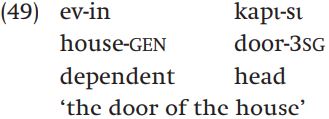x

هدف البحث
بحث في العناوين
بحث في المحتوى
بحث في اسماء الكتب
بحث في اسماء المؤلفين

اختر القسم
موافق


Grammar


Tenses


Present

Present Simple

Present Continuous

Present Perfect

Present Perfect Continuous


Past

Past Continuous

Past Perfect

Past Perfect Continuous

Past Simple


Future

Future Simple

Future Continuous

Future Perfect

Future Perfect Continuous

Passive and Active


Parts Of Speech


Nouns

Countable and uncountable nouns

Verbal nouns

Singular and Plural nouns

Proper nouns

Nouns gender

Nouns definition

Concrete nouns

Abstract nouns

Common nouns

Collective nouns

Definition Of Nouns


Verbs

Stative and dynamic verbs

Finite and nonfinite verbs

To be verbs

Transitive and intransitive verbs

Auxiliary verbs

Modal verbs

Regular and irregular verbs

Action verbs


Adverbs

Relative adverbs

Interrogative adverbs

Adverbs of time

Adverbs of place

Adverbs of reason

Adverbs of quantity

Adverbs of manner

Adverbs of frequency

Adverbs of affirmation


Adjectives

Quantitative adjective

Proper adjective

Possessive adjective

Numeral adjective

Interrogative adjective

Distributive adjective

Descriptive adjective

Demonstrative adjective


Pronouns

Subject pronoun

Relative pronoun

Reflexive pronoun

Reciprocal pronoun

Possessive pronoun

Personal pronoun

Interrogative pronoun

Indefinite pronoun

Emphatic pronoun

Distributive pronoun

Demonstrative pronoun


Pre Position


Preposition by function

Time preposition

Reason preposition

Possession preposition

Place preposition

Phrases preposition

Origin preposition

Measure preposition

Direction preposition

Contrast preposition

Agent preposition


Preposition by construction

Simple preposition

Phrase preposition

Double preposition

Compound preposition


Conjunctions

Subordinating conjunction

Correlative conjunction

Coordinating conjunction

Conjunctive adverbs


Interjections

Express calling interjection


Grammar Rules

Preference

Requests and offers

wishes

Be used to

Some and any

Could have done

Describing people

Giving advices

Possession

Comparative and superlative

Giving Reason

Making Suggestions

Apologizing

Forming questions

Since and for

Directions

Obligation

Adverbials

invitation

Articles

Imaginary condition

Zero conditional

First conditional

Second conditional

Third conditional

Reported speech


Linguistics

Phonetics

Phonology


Semantics


Pragmatics

Linguistics fields

Syntax

Morphology

Semantics

pragmatics

History

Writing

Grammar


literature


Reading Comprehension

Elementary

Intermediate

Advanced
Head- versus dependent-marking
المؤلف:
Rochelle Lieber
المصدر:
Introducing Morphology
الجزء والصفحة:
135-7
24-1-2022
601
Above, we have looked at the morphologies of languages in terms of the ease with which words can be segmented and the relationship between meaning and form in morphemes. There are other things we can look at, however, in classifying and comparing languages.
One thing we can look at is the way that morphology signals the relationship between words in phrases. The main element in each syntactic phrase is called its head; the head of a noun phrase (NP) is the noun, the head of a verb phrase (VP) is the verb, and so on. The other elements that combine with the head to become a phrase might be called the dependents of the head. Dependents of a noun can be adjectives, determiners, or possessives, and dependents of a verb can be its subject or object. Languages can choose to mark relationships between the head and its dependents in different ways: the relationship can be marked exclusively on the head, or exclusively on the dependent, or on both or neither. If the relationship is marked by some morpheme on the dependent, this is called dependent-marking, and if it is marked on the head, it is called head-marking
As illustrated in (46a), the relationship between the head noun and its possessor is marked on the possessor in English, but on the head in Hungarian (46b) (examples from Nichols 1986: 57):


The NP in English therefore shows dependent-marking between a possessor and the head noun, whereas the NP in Hungarian shows headmarking.
Whole clauses may also exhibit either dependent-marking or headmarking. In Dyirbal, NPs are case-marked to show their relationship to the verb:

Dyirbal would therefore be considered a dependent-marking language within clauses.
In contrast, the Mayan language Tzutujil shows head-marking within clauses: the verb is marked for the person and number of its subject and object, but there is no marking on the subject and object themselves to show their function in the clause (Nichols 1986: 61):

As we mentioned above, it is also possible for languages to show neither head-marking nor dependent-marking. For example, a language that is isolating and has no inflection would have neither head- nor dependent-marking. On the other hand, it is possible for a language to have inflectional markings on both the head and its dependents. Turkish, for example, marks both the possessor and the possessed noun in an NP:

When the relationship between the dependent and the head is marked on both constituents, we have what is called double-marking.